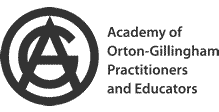 Orton Gilligham AcademyThe Academy of Orton-Gillingham Practitioners and Educators is unique in being the only organization established and authorized expressly to set and maintain professional and ethical standards for the practice of the Orton-Gillingham Approach and to certify teachers and to accredit instructional programs that meet these standards. The Academy is incorporated and operates under the New York State Education Law, its corporate status being authorized in 1995 by action of the Board of Regents of The |  The Orton Gillingham ApproachOrton-Gillingham is an instructional approach intended primarily for use with persons who have difficulty with reading, spelling, and writing of the sort associated with dyslexia. It is most properly understood and practiced as an approach, not a method, program, system or technique. In the hands of a well-trained and experienced instructor, it is a powerful tool of exceptional breadth, depth, and flexibility. |  Content and PracticeThe curricular content and instructional practices that characterize the Orton-Gillingham Approach are derived from two sources: first from a body of time-tested knowledge and practice that has been validated over the past 70 years, and second from scientific evidence about how persons learn to read and write; why a significant number have difficulty in doing so; how having dyslexia makes achieving literacy skills more difficult; and which instructional practices are best suited to teachering. |
|---|
 The ModelThe Orton-Gillingham Approach is most often associated with a one-on-one teacher-student instructional model. Its use in small group instruction is not uncommon. A successful adaptation of the approach has demonstrated its value for class-room instruction. Reading, spelling and writing difficulties have been the dominant focus of the approach although it has been successfully adapted for use with students who exhibit difficulty with mathematics. |  Language ElementsThe Orton-Gillingham Approach always is focused upon the learning needs of the individual student. Students with dyslexia need to master the same basic knowledge about language and its relationship to our writing system as any who seek to become competent readers and writers. However, because of to learn to write, read and spell, affects one in five people.
Health experts say youngsters in every classroom are dealing with it, but there's almost no expertise to identify and treat the disorder. |  SuitabilityThe Orton-Gillingham approach is appropriate for teaching individuals, small groups, and classrooms. It is appropriate for teaching in the primary, elementary, intermediate grades, and at the secondary and college level as well as for adults. The explicit focus of the approach has been and continues to be upon persons with the kinds of language processing problems associated with dyslexia. Early intervention is highly desirable, but it is never too late to begin! |
|---|
 PersonalisedTeaching begins with recognizing the differing needs of learners. While those with dyslexia share similarities, there are differences in their language needs. In addition individuals with dyslexia may possess additional problems that complicate learning. Most common among these are attention deficit disorder (ADD) or attention deficit disorder with hyperactivity (ADHD). |  Multi -sensoryIt uses all the learning pathways: seeing, hearing, feeling, and awareness of motion, brought together by the thinking brain. The instructor engages in multisensory teaching to convey curricular content in the most understandable way to the student. The teacher also models how the student, by using these multiple pathways, can engage in multi-sensory learning that results in greater ease and success in learning. |  Prescriptive and DiagnosticAn Orton-Gillingham lesson is both diagnostic and prescriptive. It is diagnostic in the sense that the instructor continuously monitors the verbal, nonverbal, and written responses of the student to identify and analyze both the student’s problems and progress. This information is the basis of planning the next lesson. That lesson is prescriptive in the sense that will contain instructional elements that focus upon the resolution of the student’s difficulties and that build upon the student’s pr |
|---|
 SystematicIt uses systematic phonics, stressing the alphabetic principle in the initial stages of reading development. It takes advantage of the sound/symbol relationships inherent in the alphabetic system of writing. Spoken words are made up of individual speech sounds, and the letters of written words graphically represent those speech sounds. |  Direct instructionThe teacher presentations employ lesson formats which ensure that the student approaches the learning experience understanding what is to be learned, why it is to be learned, and how it is to be learned. |  Sequential, Incremental, CummulativeStep by step learners move from the simple, well-learned material to that which is more and more complex. They move from one step to the next as they master each level of language skills. |
|---|